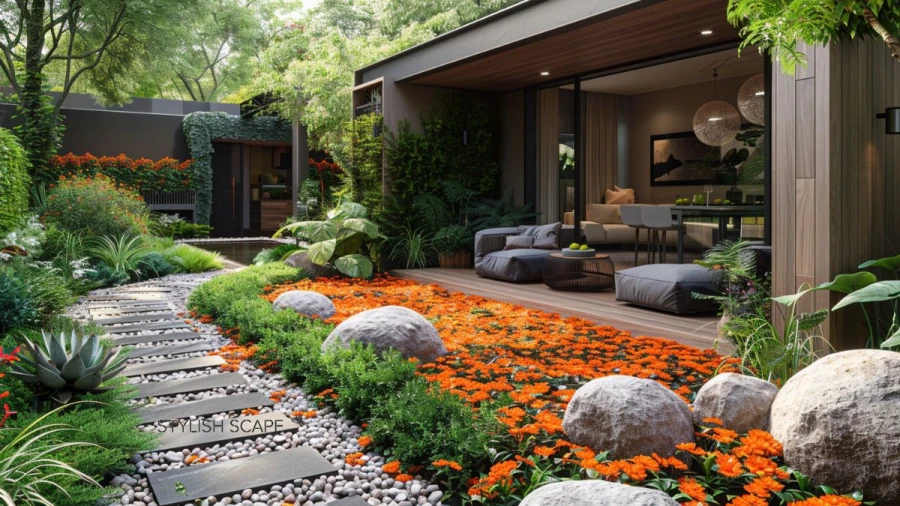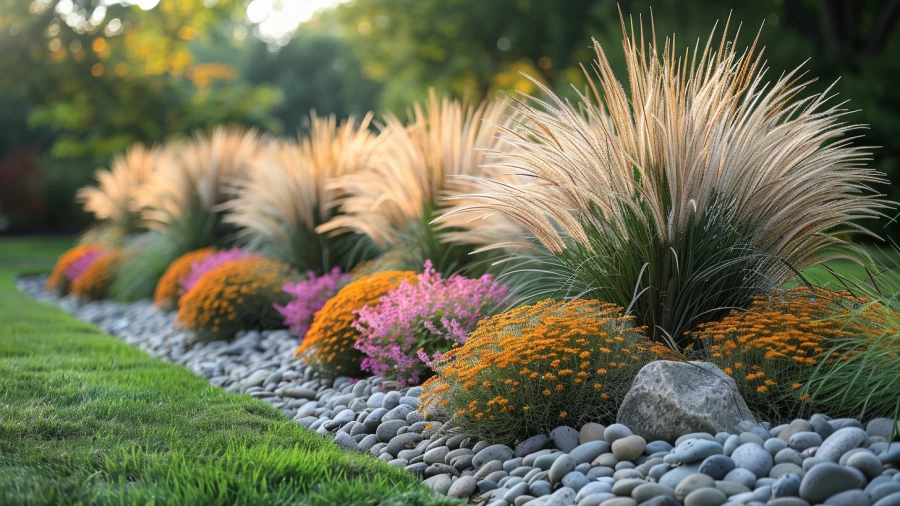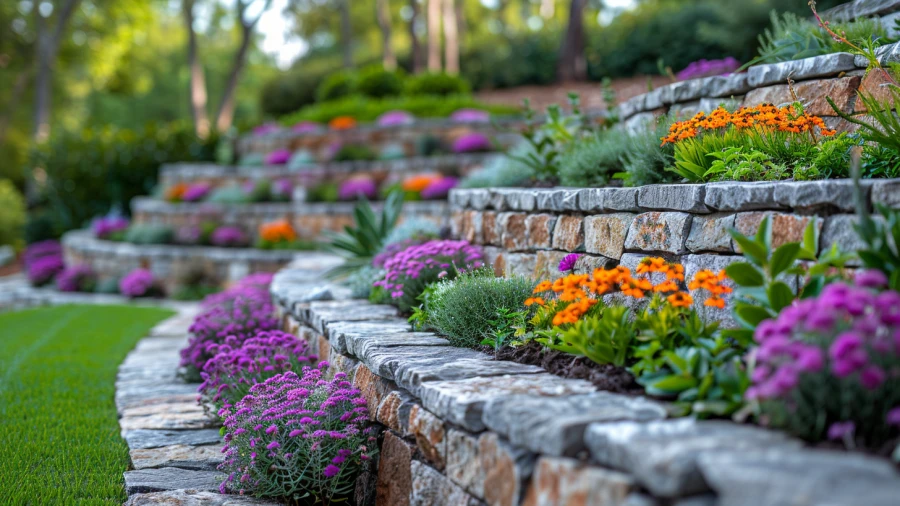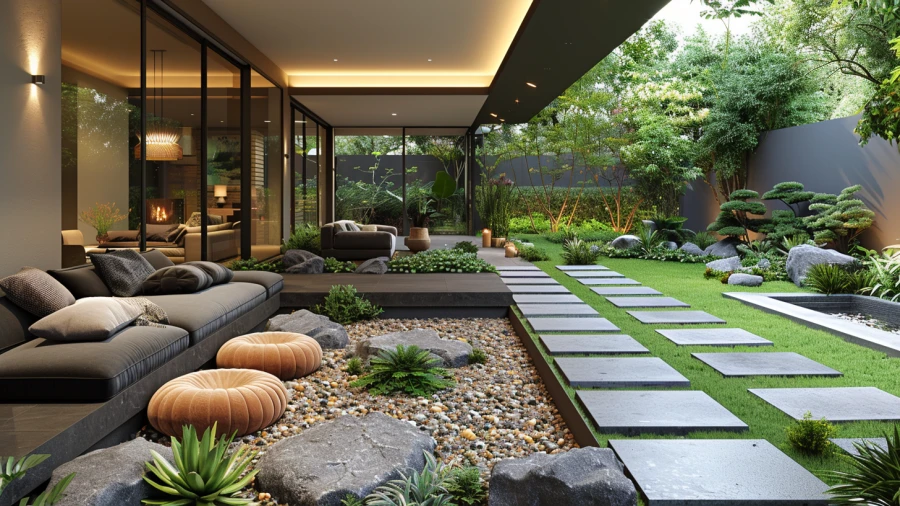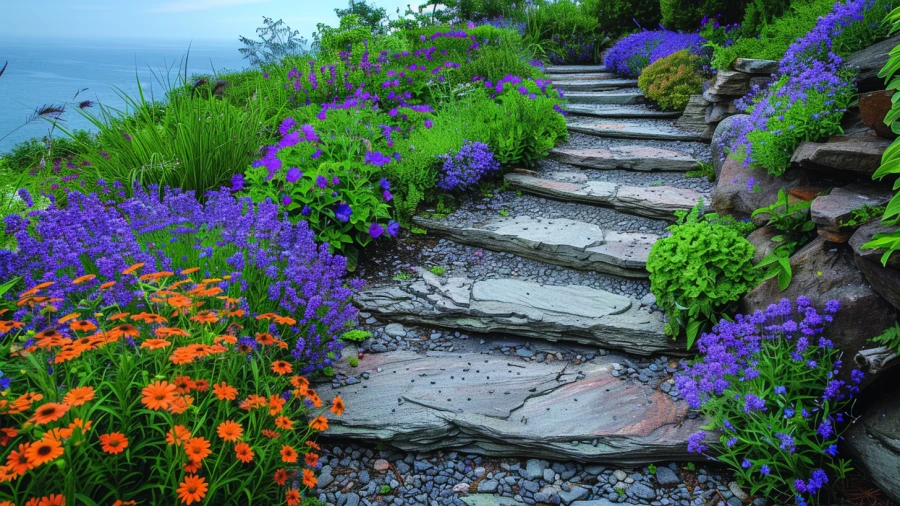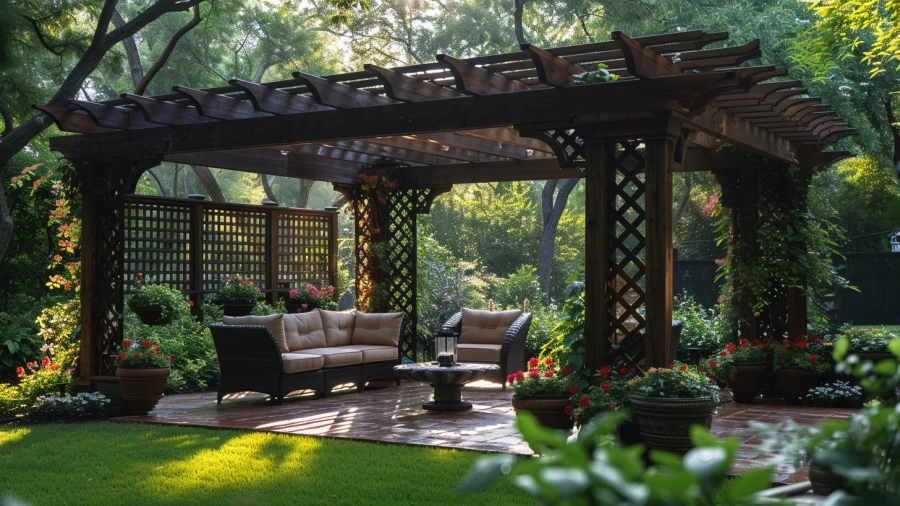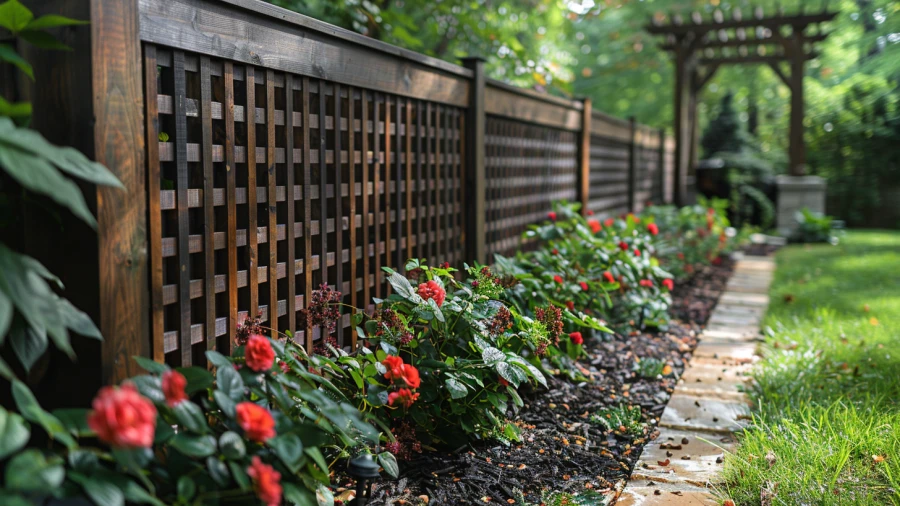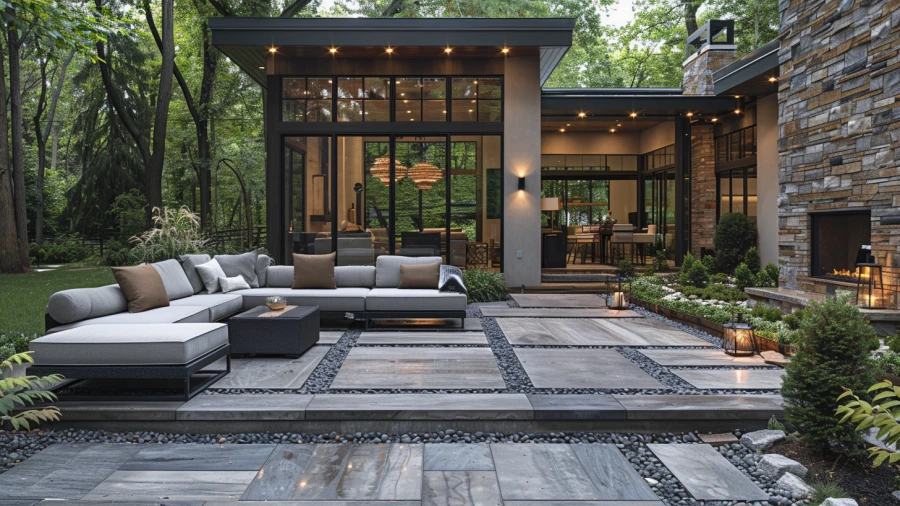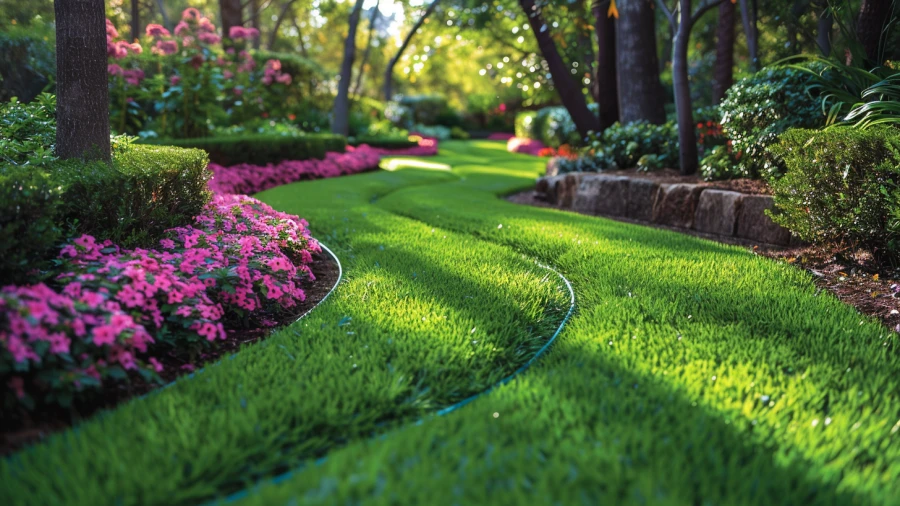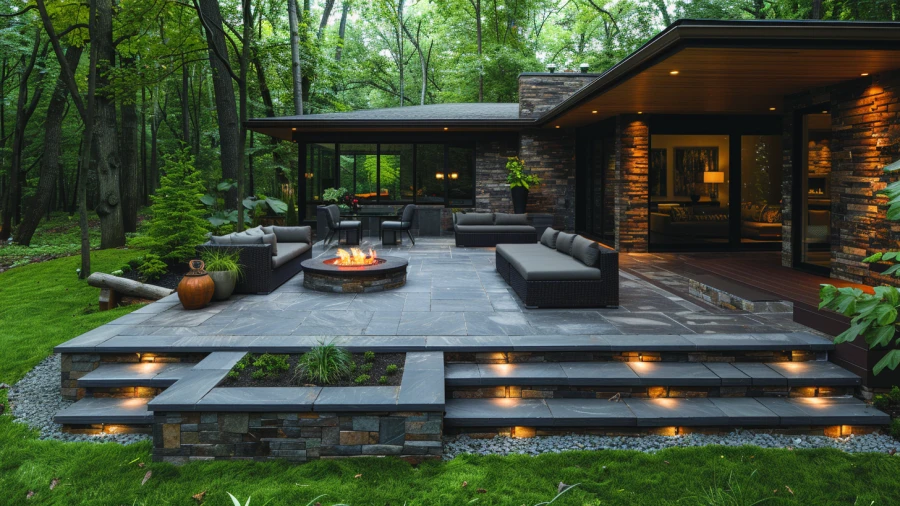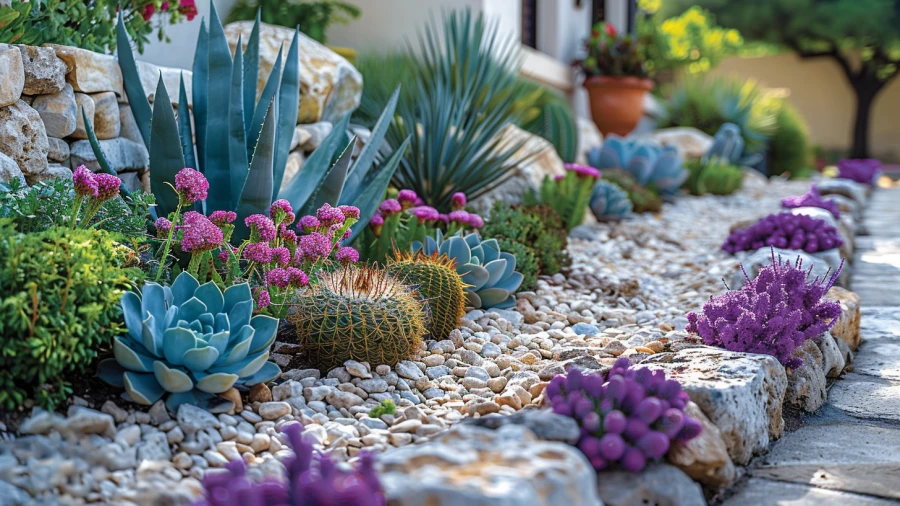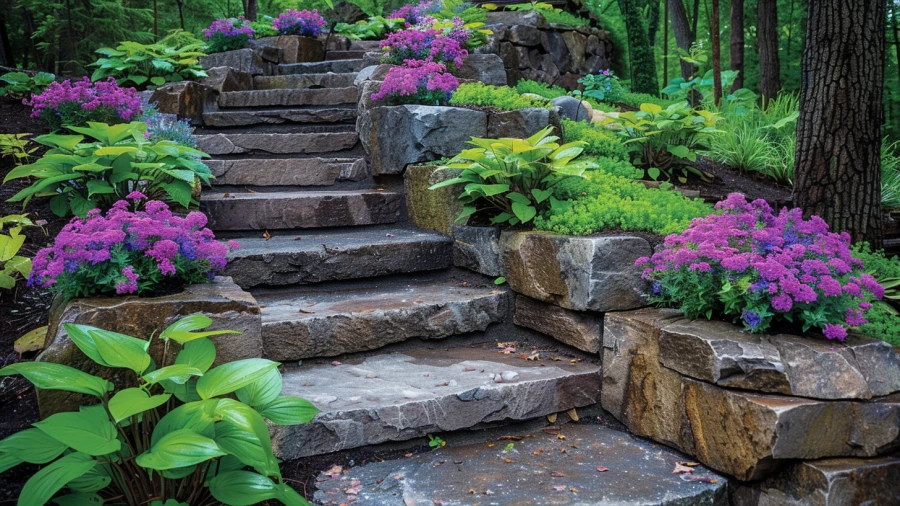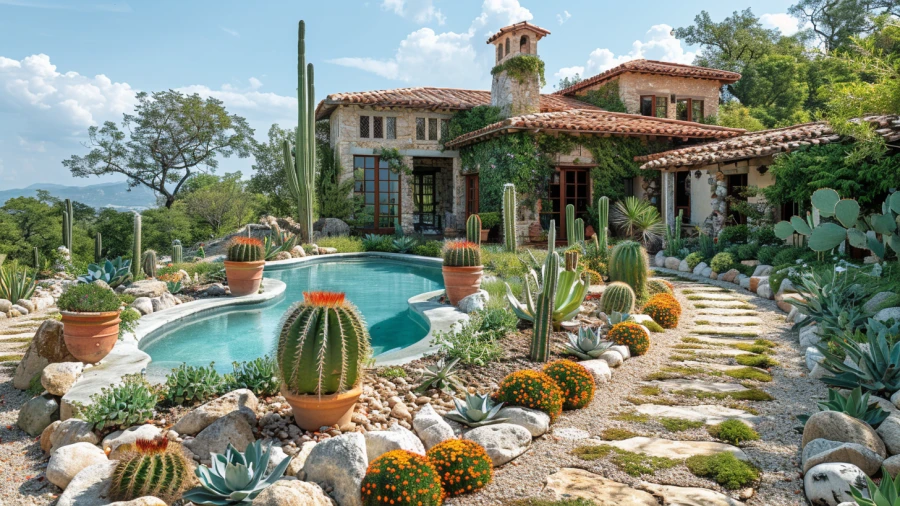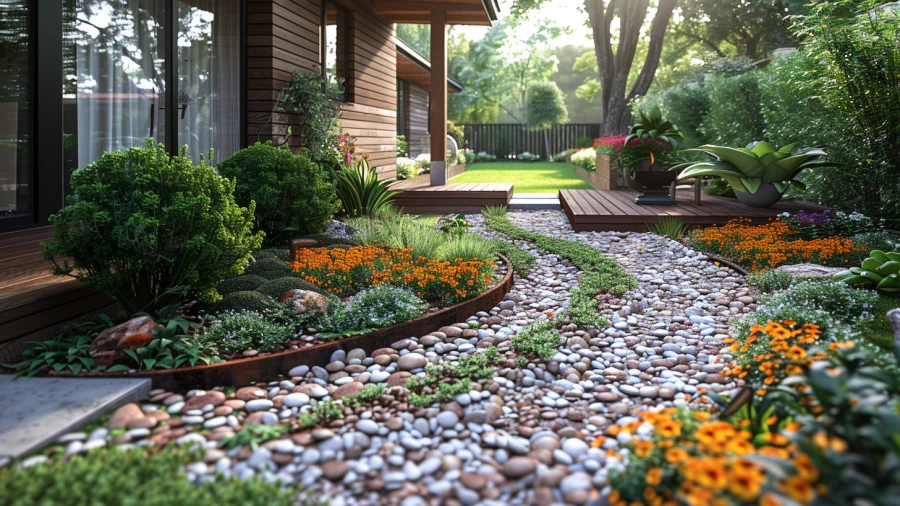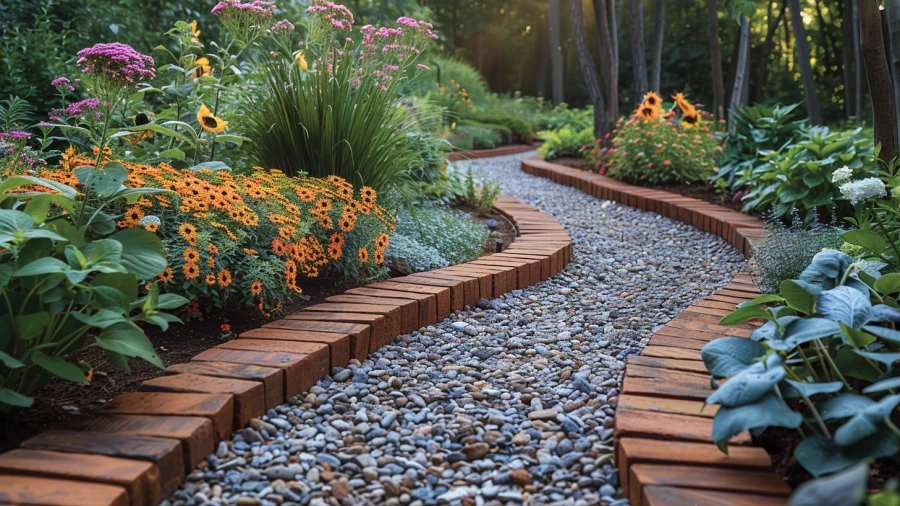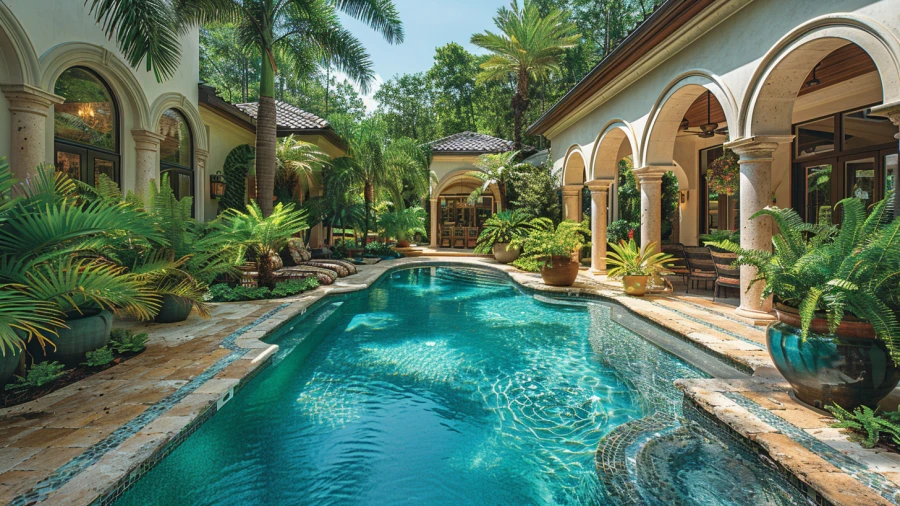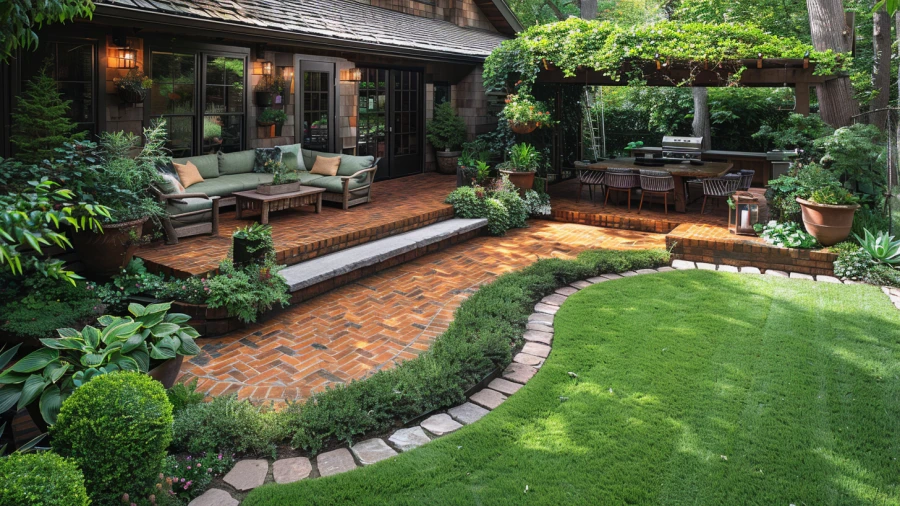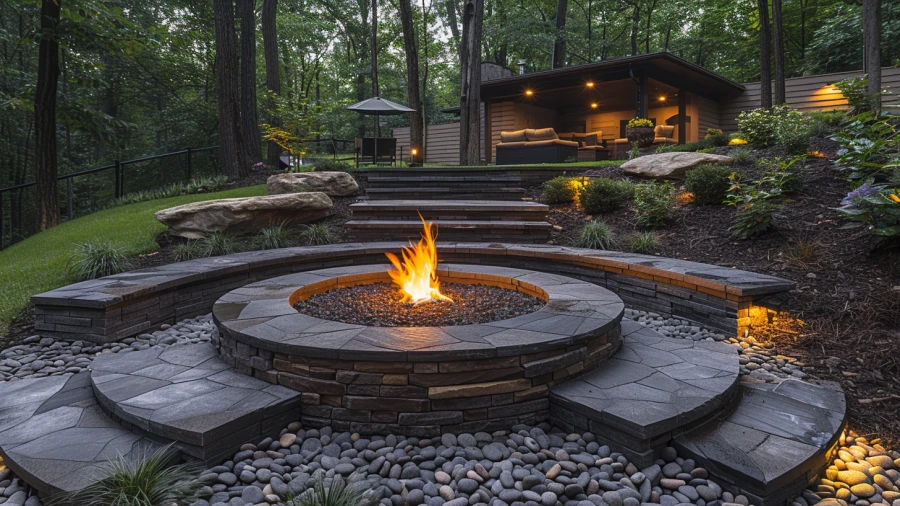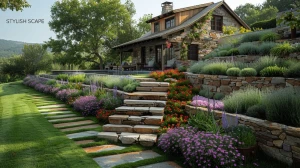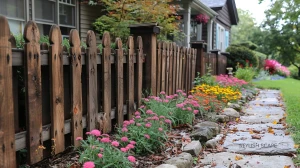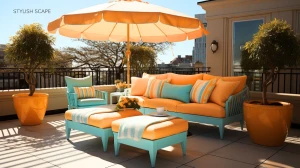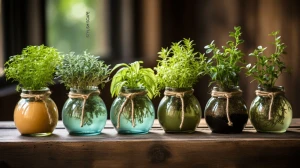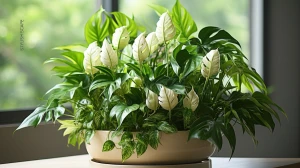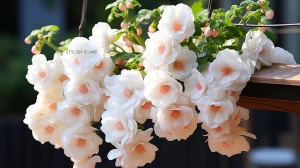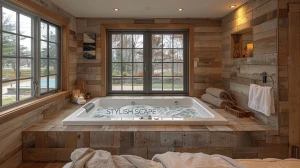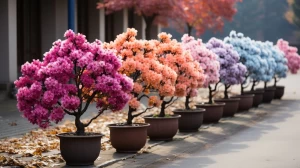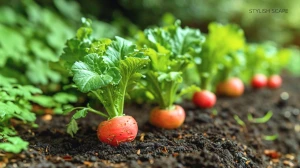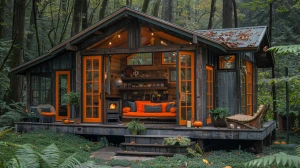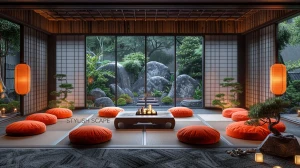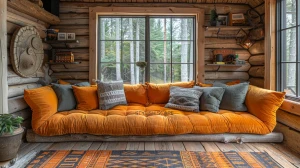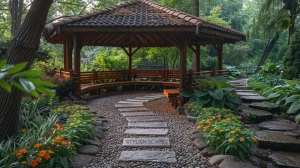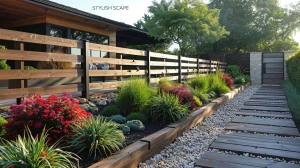
20 Creative Backyard Landscape Ideas for a Stunning Outdoor Transformation
Explore 20 Backyard Landscape ideas to transform your outdoor space. From creating a private oasis to installing modern patios, these Backyard Landscape tips will help you design a beautiful, functional, and inviting backyard.
by Priyanka P
Updated Sep 10, 2024
On This Page
- Backyard Landscape Ideas
- Create a Private Oasis with Grasses in Your Backyard
- Install a Retaining Wall with Planters
- Simplify Your Backyard with Minimalist Design
- Line Pathways with Colorful Plants
- Frame a Small Dining Nook in Your Backyard
- Add Structures to Define Areas
- Grow a Vegetable Garden in Your Backyard
- Install Open-Air Fencing
- Use Large Pavers for Modern Backyard Patios
- Create Gentle Curves with Lawns and Beds
- Build a Sunken Backyard Patio
- Incorporate Mediterranean Elements
- Design Low-Maintenance Desert Borders for Your Backyard
- Frame Stone Steps with Planters
- Use Cacti for Poolside Backyard Borders
- Prioritize Sustainability
- Shape Backyard Garden Paths with Varied Plant Heights
- Create Shaded Poolside Gardens
- Convert Lawn into a Functional Backyard Patio
- Add a Multi-Level Fire Pit Area
- What Are Some Easy Backyard Landscape Ideas For Beginners?
Backyard Landscape Ideas
Backyard landscape design is all about making your outdoor space look good and be useful. It involves choosing plants, arranging paths, and adding features like patios or fences. To start, think about what you want: do you need a place to relax, or do you want a garden? Use simple ideas like planting shrubs for privacy or laying down gravel for paths.
Low-maintenance plants like succulents or native plants can save you time and effort. You can also add structures like pergolas or fire pits to make the space more enjoyable. By planning carefully, you can turn any backyard into a beautiful, functional area that fits your needs and style.
Create a Private Oasis with Grasses in Your Backyard
Transform your backyard into a private oasis by planting tall ornamental grasses along the borders or fences. Grasses like Maiden Grass, Fountain Grass, and Pampas Grass not only add privacy but also bring a sense of calm and movement with their swaying blades. These grasses are low maintenance and grow quickly, making them perfect for creating natural barriers.
Apart from privacy, they help in noise reduction and act as windbreaks. Consider mixing different heights and types to add depth and texture to your space. Pairing grasses with wildflowers can enhance the natural feel. Add a cozy seating area nearby to create a relaxing retreat where you can unwind in nature’s embrace. With the right combination of grasses and plants, you can create a tranquil and secluded backyard getaway that’s perfect for relaxation and outdoor gatherings.
Install a Retaining Wall with Planters
If your backyard has uneven terrain or slopes, a retaining wall with planters is a practical and aesthetic solution. Retaining walls help manage soil erosion, create usable flat spaces, and add structure to your landscape. To add more visual interest, integrate built-in planters on different levels of the wall. These planters can be filled with colorful flowers, herbs, or small shrubs to soften the hardscape and add greenery.
Materials like stone, brick, or wood can be chosen to match the overall theme of your garden. You can also add a cascading water feature or a built-in bench along the retaining wall to enhance the design. Proper drainage is essential to prevent water build-up, so make sure the wall is constructed by a professional if it is over a few feet tall. This layered approach can transform your backyard into a multi-functional space with aesthetic appeal.
Simplify Your Backyard with Minimalist Design
A minimalist backyard design emphasizes simplicity, functionality, and elegance. Start by decluttering the space, removing unnecessary elements, and keeping only essential furniture and plants. Opt for a neutral color palette with shades of grey, white, or beige to create a calm and cohesive look. Choose low-maintenance plants like succulents, evergreen shrubs, and ornamental grasses that require minimal care.
Use natural materials like stone, gravel, and wood for pathways, patios, and fencing. A minimalist garden design often focuses on geometric shapes and clean lines, so consider rectangular planters or square stepping stones to maintain symmetry. Incorporate features like a simple water fountain or a fire pit to create focal points without overwhelming the space. Lighting is key; use subtle, soft lights to highlight specific areas and create a relaxing ambiance. A minimalist backyard offers a serene environment that is easy to maintain and perfect for relaxation.
Line Pathways with Colorful Plants
Lining backyard pathways with colorful plants can transform a simple garden into a vibrant and inviting space. Start by selecting plants that bloom in different seasons to ensure year-round color and interest. Consider perennials like lavender, coreopsis, and salvia for a pop of color, or choose low-growing ground covers like creeping thyme and alyssum for a more subtle approach.
Pathway borders should be planned according to the available space and light conditions. In shaded areas, opt for hostas, ferns, and heucheras, while sunny spots can feature daisies, petunias, and marigolds. Ensure that the plants chosen don’t overgrow and encroach on the walkway. Adding mulch around the plants will help retain moisture and prevent weeds. For an added layer of texture, mix flowers with ornamental grasses or small shrubs. This approach will create a dynamic and picturesque path that invites guests to explore your garden.
Frame a Small Dining Nook in Your Backyard
Create a charming outdoor dining nook in your backyard with minimal effort. Start by choosing a spot that offers some privacy, such as a corner or an area near a garden wall. Use potted plants, climbing vines, or decorative trellises to frame the space and create a sense of enclosure. An outdoor rug can help define the dining area, adding a cozy and comfortable feel.
Select weather-resistant furniture that suits your style—whether it's a metal bistro set for a chic look or a rustic wooden table and chairs for a more relaxed vibe. Add string lights or lanterns to provide soft, ambient lighting for evening meals. To enhance the atmosphere, incorporate small decorative elements like cushions, outdoor art, or candles. By thoughtfully arranging these elements, you can transform a small area into an intimate dining space that’s perfect for family gatherings or romantic dinners.
Add Structures to Define Areas
Using structures like pergolas, arbors, garden sheds, or trellises can help define different areas in a large backyard. These elements provide both function and visual interest, guiding the flow of the garden and creating designated spaces for dining, relaxing, or gardening. For example, a pergola can create a shaded seating area, while a garden shed can serve as a focal point and storage space.
Arbors can mark transitions between different garden sections, such as from a patio to a flower garden. Consider using materials that complement your home’s architecture, like wood for a rustic feel or metal for a modern touch. Adding climbing plants or vines to these structures can soften their appearance and make them blend seamlessly into the landscape.
By strategically placing structures, you can create a backyard that feels organized, spacious, and inviting, perfect for different activities and gatherings.
Grow a Vegetable Garden in Your Backyard
Growing a vegetable garden in your backyard is a rewarding way to enjoy fresh, home-grown produce. Start by selecting a sunny spot, as most vegetables require at least 6-8 hours of sunlight per day. Prepare the soil by adding compost or organic matter to improve its fertility and drainage.
Raised beds are a great option for small spaces or poor soil conditions, allowing better control over soil quality and easier maintenance. Choose vegetables that suit your climate and season—tomatoes, peppers, lettuce, carrots, and herbs like basil and parsley are popular choices for beginners.
Arrange plants according to their height and growth habits, with taller plants in the back and shorter ones in the front. Regular watering, mulching, and occasional fertilization will help ensure a healthy harvest. A vegetable garden not only provides fresh produce but also adds greenery and life to your backyard, creating a peaceful, productive retreat.
Install Open-Air Fencing
Open-air fencing is a great way to define spaces in your backyard without obstructing views or light. Unlike solid fences, open-air designs such as lattice, horizontal slats, or wire mesh allow for airflow and visibility while still providing a sense of boundary and structure. These fences are ideal for showcasing garden beds, raised planters, or climbing plants like roses and clematis, which can weave through the gaps and create a lush, green wall effect.
Wooden slats or bamboo fences offer a natural and rustic look, while metal or wire options provide a modern and industrial feel. Additionally, incorporating an arbor or a gate within the fence design can add an inviting touch to your backyard. Open-air fencing is not only visually appealing but also functional, offering privacy without completely closing off the space. This type of fencing can help make small yards feel larger and more open.
Use Large Pavers for Modern Backyard Patios
Large pavers are a stylish and practical option for creating modern backyard patios. They provide a clean, contemporary look and can be laid in various patterns to suit different styles. Pavers come in various materials, such as concrete, stone, or porcelain, each offering unique textures and colors. When installing large pavers, consider spacing them apart and filling gaps with gravel, ground covers like creeping thyme, or low-growing succulents to add interest and reduce maintenance.
The use of oversized pavers helps to create a sense of scale and makes the space feel expansive. Ensure the ground is well-prepared and leveled before laying the pavers to avoid uneven surfaces. Pair the patio with modern outdoor furniture, minimalist planters, and subtle lighting to complete the sleek look. This approach offers a durable and low-maintenance solution that is perfect for both entertaining and everyday outdoor living.
Create Gentle Curves with Lawns and Beds
Introducing gentle curves to your lawn and flower beds can add a dynamic flow to your backyard landscape. Unlike straight lines, curves create a sense of movement and natural rhythm, guiding the eye through the garden and making the space feel larger. Start by outlining the curves with a garden hose or rope before committing to the shape.
Plant low-growing shrubs, perennials, and ornamental grasses along the curved edges to soften the transition between lawn and beds. This design can work well for both formal and informal gardens, depending on the choice of plants and materials. Using mulch or gravel to define the edges can also help to highlight the curves and provide a clean finish.
Incorporate pathways that follow the contours of the curves to lead visitors through different areas. This organic approach adds visual interest and a sense of tranquility to your outdoor space.
Build a Sunken Backyard Patio
A sunken patio is a unique and inviting feature that adds depth and character to a backyard. By lowering the seating area, you create a more intimate and cozy space that feels like an outdoor room. Start by choosing a location that naturally slopes or where you can excavate a few feet down. Use retaining walls made of stone, brick, or wood to define the sunken area and provide built-in seating or planter beds.
Add steps leading down to the patio to enhance the sense of enclosure and provide easy access. For the flooring, consider using flagstone, pavers, or gravel to create a natural look. Adding a fire pit, water feature, or outdoor lighting can enhance the ambiance and make the sunken patio a focal point for relaxation and entertaining. Surround the area with lush greenery to blend it into the landscape and create a peaceful retreat.
Incorporate Mediterranean Elements
Incorporating Mediterranean elements into your backyard design can create a warm and inviting outdoor space reminiscent of the coastal regions of Spain, Italy, and Greece. Start with natural materials like terracotta tiles, stone, and wood for pathways, patios, and walls. Plant drought-resistant plants like lavender, rosemary, olive trees, and succulents to evoke the look and feel of a Mediterranean garden.
Use ceramic pots and urns filled with vibrant flowers to add color and charm. Consider adding a water feature, like a small fountain or a reflecting pool, to bring a soothing sound to the environment. Incorporate a pergola or trellis with climbing vines to provide shade and enhance the ambiance.
Comfortable, rustic furniture, woven textiles, and mosaic-tiled surfaces can complete the look. This style is not only visually appealing but also functional and low-maintenance, ideal for areas with hot, dry climates or for those looking to create a relaxing retreat.
Design Low-Maintenance Desert Borders for Your Backyard
Low-maintenance desert borders are ideal for homeowners who want a beautiful landscape without much upkeep. This design style emphasizes drought-tolerant plants like cacti, agave, yucca, and succulents, which require minimal watering and care. Start by choosing a variety of plants that provide different textures, heights, and colors to create a dynamic and visually appealing border.
Use rocks, pebbles, or gravel as ground cover instead of traditional mulch to give it a desert-like appearance and reduce weed growth. Consider adding elements like large boulders, driftwood, or metal sculptures to add visual interest and define spaces. Raised beds or terraced borders can also enhance the look by creating levels and depth.
Ensure proper drainage, as desert plants do not thrive in waterlogged soil. With thoughtful planning and the right selection of plants, you can create a striking and sustainable backyard border that captures the beauty of a desert landscape.
Frame Stone Steps with Planters
Framing stone steps with planters adds a touch of elegance and greenery to your backyard, enhancing both functionality and aesthetics. Start by selecting natural stone that complements your garden style and layout for the steps. Flank the sides of the steps with built-in or movable planters filled with a variety of plants.
Choose plants that thrive in your local climate, and consider using cascading flowers like petunias, lobelia, or ivy to soften the hard edges of the stone. For a more structured look, consider shrubs like boxwood or dwarf conifers. Incorporating herbs like rosemary or lavender can add both fragrance and texture.
The planters can be made from stone, terracotta, or metal, depending on the overall theme of your landscape. This approach not only creates a visually appealing pathway but also makes the stairs a focal point, guiding visitors through the garden in a welcoming manner.
Use Cacti for Poolside Backyard Borders
Using cacti for poolside backyard borders creates a striking and low-maintenance landscape that thrives in sunny conditions. Cacti are ideal for hot, dry climates where traditional plants may struggle to survive. Select a variety of cacti species like Golden Barrel, Prickly Pear, and Saguaro, along with succulents like Agave and Aloe Vera, to add different textures and shapes to the border.
Plant them in well-draining soil mixed with sand or gravel to prevent water retention. Adding decorative rocks, pebbles, or sand around the cacti enhances the desert-like aesthetic. Consider placing larger cacti as focal points and smaller ones as fillers. Avoid placing cacti too close to high-traffic areas to prevent accidents. With the right arrangement, you can create a beautiful and sustainable poolside landscape that requires minimal watering and care, all while adding a unique, southwestern flair to your backyard.
Prioritize Sustainability
Creating a sustainable backyard landscape is both eco-friendly and cost-effective. Start by choosing native plants and drought-resistant species that thrive in your local climate and require less water, fertilizer, and maintenance. Incorporate rain gardens or swales to manage rainwater runoff and promote groundwater recharge. Composting kitchen waste and using organic mulch can enrich the soil and reduce the need for chemical fertilizers.
Consider using permeable materials like gravel, brick, or porous pavers for walkways and patios to allow water to seep into the ground, reducing runoff. Solar-powered lighting and water features can also help lower energy consumption. Installing a rain barrel or a drip irrigation system can help conserve water by providing efficient irrigation to plants. By making sustainable choices in design and maintenance, you can create a backyard that is not only beautiful but also supports the environment and local wildlife.
Shape Backyard Garden Paths with Varied Plant Heights
Shaping backyard garden paths with varied plant heights can add depth and dimension to your landscape design. Start by choosing a pathway material such as gravel, stepping stones, or brick, and then plan the planting layout around it. Use tall plants like ornamental grasses, sunflowers, or hollyhocks at the back of the borders to create a backdrop.
Mid-height plants such as lavender, salvia, or echinacea can be placed in the middle, while low-growing ground covers like creeping thyme, sedum, or alyssum can fill in the front. This layered approach creates a natural flow that draws the eye along the path, encouraging exploration. Consider mixing flowering plants with evergreens and shrubs to provide year-round interest. Adding a few focal points, such as a bench, sculpture, or birdbath along the path, can further enhance the visual appeal and provide resting spots.
Create Shaded Poolside Gardens
Creating shaded poolside gardens can provide a cool and comfortable retreat while adding a lush, tropical feel to your backyard. Start by planting tall, dense trees like palms, magnolias, or bamboo around the pool to provide shade and privacy. Underneath, plant shade-loving perennials like hostas, ferns, and caladiums, which thrive in the cooler, shaded areas.
Incorporate large potted plants, such as banana plants or bird of paradise, to add height and texture. Use natural materials like stone or wood for poolside pathways to create a cohesive look. Adding an overhead structure like a pergola with climbing vines or retractable shade sails can offer additional sun protection. Consider water-friendly and non-slip materials for safety around the pool. With the right combination of plants and shade solutions, you can create a serene poolside environment that feels like a private oasis, perfect for relaxation and entertaining.
Convert Lawn into a Functional Backyard Patio
Converting a lawn into a functional backyard patio can maximize outdoor living space while reducing maintenance. Start by determining the patio size and location that best fits your needs. Clear the grass and prepare the ground by leveling and compacting the soil. Use pavers, bricks, or stamped concrete to create a durable and visually appealing surface. To define the space, add planters, low walls, or hedges around the patio.
Consider incorporating a built-in grill, fire pit, or outdoor kitchen to make it a perfect spot for entertaining. Choose comfortable and weather-resistant furniture that complements the style of your home and garden. Adding a pergola or umbrella can provide shade and make the space more usable in hot weather. By transforming a grassy area into a versatile patio, you create a low-maintenance outdoor area that’s perfect for dining, relaxation, and social gatherings.
Add a Multi-Level Fire Pit Area
Adding a multi-level fire pit area can create a dynamic and engaging outdoor space perfect for social gatherings and relaxation. Start by choosing a location that provides a safe distance from structures and overhanging trees. Create different levels using retaining walls, stone steps, or terraced landscaping to define various seating or activity areas around the fire pit. For the fire pit itself, choose between options like built-in stone or portable metal fire pits based on your style and budget.
Surround the pit with comfortable seating, such as built-in benches, Adirondack chairs, or cushioned sofas. Use gravel, pavers, or flagstone for the flooring to create a durable and easy-to-maintain surface. Incorporate accent lighting, such as solar lanterns or string lights, to enhance the ambiance at night. By adding a multi-level fire pit area, you create a cozy and functional focal point for your backyard that can be enjoyed year-round.
What Are Some Easy Backyard Landscape Ideas For Beginners?
- Potted Plants: Start with potted plants for easy maintenance and flexibility in placement.
- Simple Pathways: Use gravel, stepping stones, or mulch to create easy-to-install pathways.
- Low-Maintenance Plants: Choose plants like succulents, ornamental grasses, or native species that require minimal care.
- Basic Garden Beds: Create simple garden beds with a few easy-to-grow flowers or vegetables.
- Outdoor Furniture: Add a bench or a small table and chairs to create a cozy spot.
- Privacy Screens: Use tall plants or inexpensive lattice panels for privacy.
- Mulch: Apply mulch around plants to reduce weeds and retain moisture.
- Lighting: Install solar-powered lights along pathways or in garden beds for ambiance and safety.
Backyard Landscape Ideas - FAQs
1. How can I create privacy in my backyard landscape?
You can use tall grasses, shrubs, or trees to create natural barriers. Adding privacy fencing, lattice panels, or trellises with climbing plants can also provide a secluded and cozy backyard environment.
2. What are low-maintenance backyard landscape options?
Consider using drought-tolerant plants, native plants, or succulents. Gravel or mulch paths, desert borders, and raised beds can reduce maintenance and watering needs while still providing a beautiful landscape.
3. How do I make a small backyard look bigger with landscaping?
Use vertical gardening, mirrors, and light-colored paving materials. Create defined zones for dining or relaxation, and use curved paths to draw the eye through the space, making it appear larger.
